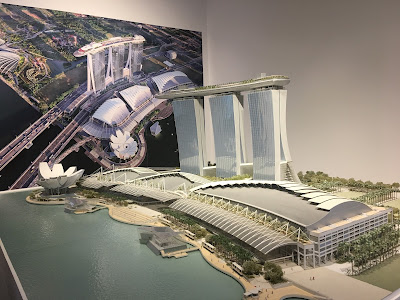The future isn't what it used to be. (Statement byFrench poet P. Valery often attributed to Yogi Berra)
 |
| Canada pavilion and viewing platform (website) |
The exhibition consists of 19 works by contemporary Quebec and Canadian artists, including 16 new works. Architecture, sound art, visual art, film and music are the poles around which this creative endeavour turns. Driven by committed artistic and archival research, the artworks highlight the exceptional creative liberty given to the artists, architects, filmmakers and designers who took part in the original exhibition (MAC website)The World Exhibition mania which began 1851 in London and has since transformed many cities. While world fairs continue to this day, this year it is in Kazakhstan, they don't garner much attention anymore. The excitement about them may have, indeed, reached its height in 1967 with Montreal's Expo. The exhibition prophecy of the future also shows that the future didn't come to pass the way exhibitors imagined it.
 |
| Buckminster Fuller geodesic dome in 2017 (Photo: Philipsen) |
This was a time when the future seemed bright, the oil crisis had not yet hit and the global village was a new moniker for a smaller world in which all people would get along. The world as a village was furthered by images from space that showed earth as a pretty but small planet.
It seemed that the whole world was paying attention to the pavilions erected for the Expo as exponents of what a country stood for. Most countries wanted to look future oriented. Maybe most famous was the US pavilion, Buckminster Fuller's geodesic dome, an aspiring and innovative symbol for unlimited possibilities. It still stands and is still the world's largest structure of its kind. Dreams of such domes covering entire cities never came to pass and the utility of spaceframes was reduced to structures such as the roof of the BWI airport.
A 1974 fire robbed burnt the acrylic panels of the US pavilion and the structure now stands bare, home to a biospehere exhibit and a subway station.
In 1967 Germany's pavilion was a precursor of the 1972 Olympic tents in Munich, a tensile structure that like Bucky's dome demonstrated lightweight, moment-free construction that architects around the world saw in their future, along with mono-rails, air transport and a heavy use of all kinds of plastic.
 |
| Inside the space frame, above the landing pad for the now demolished monorail (Photo: Philipsen) |
As in other such future themed fairs, the focus was entirely on technology and no effort was made to anticipate social change. The Expo was the story of man and Calder contributed a sculpture of man. The women of the Expo were pretty decoration and the future was envisioned as a continuation of white men's dominion. But already in 67 social structures had begun to crack, for civil rights, for women's rights, against environmental degradadtion and against imperial wars. The cracks evolved to full scale turmoil in much of the western world. But the Expo in Montreal wouldn't provide a hint of that.
 |
| The role of women in 1967 (Photo: website) |
The most lasting architectural project of the Expo in Montreal isn't part of the current MAC exhibit and wasn't a part of the Expo itself either: Moshe Safdie's Habitat mountain of modular housing boxes stacked up like so many shipping containers, an object that had been invented and patented only 11 years earlier. The project made the 28 year old architect famous for life. It is another one of the many attempts to make housing affordable, different and oriented towards industrial style production.
The modular unit is the base, the means and the finality of Habitat 67. 354 magnificent grey-beige modules are stacked one on another to form 148 residences, nestled between sky and earth, city and river, greenery and light. It all comes together in a gigantic sculpture of futuristic interiors, links, pedestrian streets and suspended terraces, aerial spaces, skylights of different angles, large esplanades and monumental elevator pillars. Habitat 67 is an invitation to contemplation. (Habitat 67)Safdie's Habitat is also lasting not only because the Montreal project still stands and has even received its own postal stamp this year but also because his office has kept refining the idea of a Habitat formed from residential clusters ever since all the way to current days when "fractualizing" and modularity are en vogue again. In 67 the Habitat homes were with a cost of over $100,000 per unit anything but affordable and the fully prefabbed kitchen and bath units made from plastics and concrete never took off.
Safdie's Habitat in Montreal (Photo: Exhibit at UQAM Design Center)
 |
| Safdie model of Habitat Montreal (model at UQAM Design Center, Montreal) |
Judging from the interest in the Expo 1967 on occasion of Canada's 150th anniversary, this particular Expo is still going strong fifty years later, its yearning for a better and peaceful future still resonates, even if the real world turned out to become quite a bit different than anticipated back then.
Klaus Philipsen, FAIA
History Rebooted (NYT)
Huffington Post about the exhibit (in French)
 |
| Safdie, 28, explains his Habitat project in 1967 (from CBC documentary) |
 |
| Safdie model of Singapour project 2006 (model at UQAM
Design Center, Montreal)
Frei Otto German pavilion, Expo 67 (Website)
|


No comments:
Post a Comment